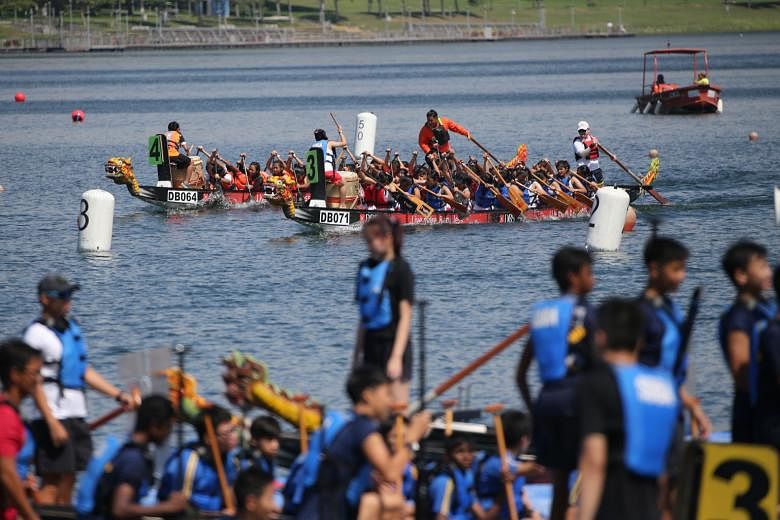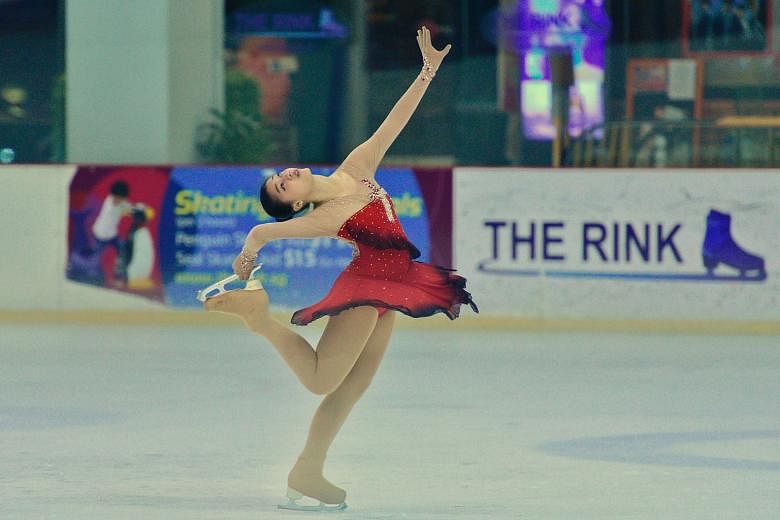The JCube ice rink was abuzz with excitement and anxiety on a Wednesday night as close to 100 pupils and students from various primary and secondary schools filling the stands awaited their turn to showcase their talent on ice.
Decked in shimmering dresses, leotards and skintight suits, they were competing in the fifth edition of the inter-school ice skating competition organised by the Singapore Ice Skating Association (Sisa).
Sisa is one of at least six national sports associations (NSA), whose sport is not part of the National School Games (NSG), to organise its own inter-school competitions to identify and groom talent.
The NSG, co-organised by the Singapore Primary Schools Sports Council and the Singapore Schools Sports Council, feature 21 sports at the primary school level and 28 sports at the secondary school and junior college levels.
CRITERIA TO BE PART OF NSG
In the last decade, sports like fencing, floorball and taekwondo were introduced to the NSG fold.
The Ministry of Education's (MOE) student development curriculum division director Tan Chen Kee told The Straits Times: "To ensure the suitability of any sport, MOE would conduct robust trials with the NSA concerned before fully introducing it into the NSG.
"Within the last 10 years, fencing, floorball, and taekwondo were introduced after consultation with various stakeholders and their respective NSAs."
Various NSAs noted one criterion for a sport to be considered for the NSG is that they have to show they have the numbers to compete consistently over a period of time.
On good years, the Handball Federation of Singapore (HFS) sees about 15 to 18 schools participating, but the numbers can dip below 10.
The association is largely reliant on the support of schools and teachers to oversee these competitions.
HFS vice-president Kristian Thorbjornsen said: "I don't blame them. It's common knowledge that teachers are overloaded.
"There's that reluctance to take up that responsibility of more roles, especially if it doesn't directly contribute to any key performance indicators."
Since the Singapore Dragon Boat Association (SDBA) last approached the MOE in 2015, it has seen participation in their annual inter-school games rise from over 20 to 33 secondary schools this year.
Sport climbing had also sought entry four years ago but was told by the MOE's Co-curricular Activities Branch (CCAB) that the NSG calendar was full.
The Singapore Mountaineering Federation secretary Rasip Isnin said: "We told CCAB that we can manage the budget, we have a handful of teachers who are climbers so they were willing helpers. But, because of the calendar and too many games, climbing could not be included."
INTEREST GROUPS, NOT CCAs
A further obstacle is some sports are being classified as interest groups and not CCAs, and this might require students to take up an activity offered by the school as part of the needed extra-curricular activities.
Figure skater Xue Silu is a member of the chess club at Raffles Girls' Primary School because ice skating is not considered a CCA.
The Primary 5 pupil said: "Chess also has competitions and practices, but if I just focus on that, I don't have time for ice skating.
"It's hard some days because sometimes people ask you if you want to quit something and you're in a dilemma because you don't have time for all of them. I've got no choice but I have to juggle all. Even if I have no time, I've got to squeeze it in."
Trying to manage multiple extra-curricular activities is a challenging task, noted Sisa president Sonja Chong, and her counterpart at Ultimate Players Association Singapore, Edmond Leong agreed.
He had seen many promising ultimate frisbee players drop out because they could not cope with multiple CCAs.
Currently, nine junior colleges and International Baccalaureate schools recognise ultimate frisbee as a CCA though the sport has yet to extend its reach to secondary schools. But the association has plans to do so next year.
Even football, Singapore's No. 1 sport, faces challenges. Last month, the Football Association of Singapore (FAS) expanded its Inter-School Futsal Challenge to include a girls' category, and more teams in the boys' event.
FAS general manager for youth development Varatha Rajan Subramaniam said he hopes the growing participation in futsal - a five-a-side format played on a hard court - will open doors for it to eventually be recognised as a CCA.
Even without official CCA status for some sports, there are policies in place to encourage students to pursue their interests.
MOE has the Leaps 2.0 system, which gauges students' progress in both official and non-official CCAs.
Their accomplishments are banded into three tiers: excellent, good and fair, where they are awarded two, one and zero bonus points respectively. These points can be used for admission to junior colleges, polytechnics and institutes of technical education.
DEVELOPING A PATHWAY
Most of the NSAs stressed being part of the NSG is crucial to grooming young talents and increasing the sport's talent pool.
The national dragon boat team are drawn mostly from the tertiary institutions because it is a more common activity among the polytechnic and university students, but the association hopes to cut down the amount of time needed to develop the rowers.
Said SDBA general manager Raizal Abdol Jalil: "It's a pathway for the sport. In the long run, mass participation will also equal to high performance where we're talking about the national team.
"If the person can become proficient at a much younger age, it will cut down on the development time and phase. Once they go into the national team, we can go straight to high-performance tactics and strategy."
BUILDING A SPORTING SINGAPORE
The 2017 National Sports Participation Survey showed the percentage of Singaporeans who did not participate in sports shrank from 29 per cent in 2015 to 19 per cent in 2017.
Earlier this year, Sport Singapore (SportSG) launched the strategic partnership co-curricular activities initiative, which falls under the Children and Youth Sport framework and part of the Vision 2030 national blueprint for sport.
Under this programme, students are able to pursue their sporting interests and represent their schools in national competitions, even if the schools do not offer the sport as a CCA. They also receive CCA points recognition.
Touching on this scheme during a Vision 2030 update earlier this week, SportSG chief executive Lim Teck Yin said: "That's where we need to be able to make the real difference. We need to get pre-schoolers and young children to be physically literate and make sure that we can partner MOE and our schools so that schools have enough capacity to offer multiple sports to the students, provide for support for in-school programmes and out-of-school programmes."



